Click here to view The Communication Bill of Rights

Follow Us on Facebook
View Our Facebook Reviews

|
Click on each circle to learn more about AAC
What is AAC?
 AAC, or Augmentative and Alternative Communication, is a phrase describing a collection of methods of communicating information for people who have difficulty communicating via speaking or writing. AAC includes sign language, gestures, visual regard, pointing, writing, typing, spelling on alphabet boards, selecting words or pictures from a book or tablet, pushing switches to activate pre-recorded messages, sophisticated computerized voice output systems, among others. AAC, or Augmentative and Alternative Communication, is a phrase describing a collection of methods of communicating information for people who have difficulty communicating via speaking or writing. AAC includes sign language, gestures, visual regard, pointing, writing, typing, spelling on alphabet boards, selecting words or pictures from a book or tablet, pushing switches to activate pre-recorded messages, sophisticated computerized voice output systems, among others.
"Unaided" AAC refers to any form of communication other than speech that involves the individual's own body. This includes sign language, facial expressions, eye pointing, vocalizations, etc.
"Aided" AAC refers to any form of communication that involves using a piece of equipment whether it be paper and pencil, pictures, symbols, books, computers, etc. Low tech aided AAC systems are those that do not require an additional power source such as batteries or electricity to operate. This would systems such as picture books, object boards and alphabet boards. In contrast, High tech AAC systems are those that do require a power source such as computers and other electronic type devices that speak when activated.
AAC Myths
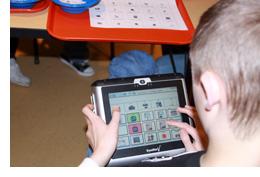 Myth #1: "Using AAC will interfere with your child's ability to learn to talk." Myth #1: "Using AAC will interfere with your child's ability to learn to talk."
The Truth: The use of AAC, whether it be low tech such as sign language and picture books or high tech such as switch devices and computerized voice output systems actually ENHANCE speech and language learning. Berry (1997) states that, "Parents should be told that extensive research has demonstrated that the use of non-speech communication systems does not reduce the motivation for speech communication, and in fact, seems to facilitate speech." The consistent speech model of voice output devices is theorized to be a positive influence on speech development, as is the pairing of visual symbols with the auditory words.
Myth #2 "If my child gets an AAC system, they will get lazy and give up on using speech."
The Truth: Taking the pressure off of using verbal speech as the only means of communication coupled with the benefits of continued language learning often helps children to develop speech. Children will automatically resort to the most efficient means of communication, which is speech and/or vocalization over some form of AAC. In a review of the literature, Light & Schlosser (2006) discovered that after the introduction of AAC, 89% of those studied Increased their speech production, 11% demonstrated no change in the speech production and none of those studies decreased their speech production.
MYTH: #3 Children and adults with significant intellectual challenges obtain minimal benefit from AAC
The Truth: In fact, the opposite is true. The tangible nature of many AAC systems such as pictures and object boards can make the symbolic nature of language more salient. Additionally, there is an increase in learning to be a communicator because the AAC system actually encourages others to communicate more to the user than if there was no system in place.
Myth #4 My Child is talking so there is no need for AAC
The Truth: That might be true…or not. Or, perhaps that is sometimes true. Often familiar people are able to understand and communicate well with their children but other folks can not. In these cases, AAC is necessary for those times when the individual is not understood; maybe at school, or church, or at boy scouts, or perhaps during periods of fatigue or in noisy environments. Everyone deserves the right to be able to fully express themselves despite the environmental conditions.
Myth #5 There is such a large cognitive delay
The Truth:
Myth #6 My child is too young to need or benefit from AAC
The Truth:The reality is, it is important to introduce AAC as early as possible. that the younger the child is, the more quickly AAC will benefit them. Research has demonstrated that when we empower children through some form of communication; it is easier to work on verbal speech. As children learn language and communication skills via their AAC, they also develop things to talk about and want to express their opinions. Being able to tell others what they want or being able to tell others what to do is motivating for children and encourages them to also use their verbal speaking skills no matter how limited they may be at the present.
References:
Berry, J.O. (1997) "Strategies for Involving Parnets in Programs for Young Children Using Augmentative and Alternative Communication." Augmentative and Alternative Communication, vol. 3, pp. 90-93.
Bodine, C. & Beukelman, D. R. (1991). "Prediction of future speech performance among potential users of AAC systems: A survey." Augmentative and Alternative Communication, 7, 100-111.
Light, J., Beukelman, D., & Reichle, J. (2003). "Communicative competence for individuals who use AAC: From research to effective practice." Baltimore: Paul H. Brookes Publishing.
Van Tatenhove, G. M. (1987). "Teaching power through augmentative communication: Guidelines for early intervention." Journal of Childhood Communication Disorders, 10, 185-199.
"Myths - AAC will keep someone from talking." DynaVox Mayer-Johnson Implementation Toolkit, Retrieved January 5, 2010 from www.dynavoxtech.com/training/toolkit/ details.aspx?id=373
Who Benefits?
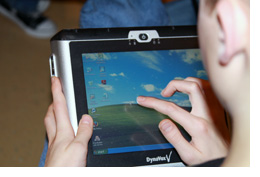 Anyone who is experiencing short term or long term difficulties communicating through traditional speech will benefit from some form of AAC, whether it be "high tech" or "low tech". Some examples of people who benefit from AAC include individuals with cerebral palsy, Down Syndrome, autism, developmental delays, apraxia. Other people who might benefit are those whose communication skills have been reduced due brain injury, stroke, accidents or illnesses such as meningitis, ALS and Parkinson's Disease. Anyone who is experiencing short term or long term difficulties communicating through traditional speech will benefit from some form of AAC, whether it be "high tech" or "low tech". Some examples of people who benefit from AAC include individuals with cerebral palsy, Down Syndrome, autism, developmental delays, apraxia. Other people who might benefit are those whose communication skills have been reduced due brain injury, stroke, accidents or illnesses such as meningitis, ALS and Parkinson's Disease.
What To Expect From an Alternative & Augmentative Communication (AAC) Evaluation
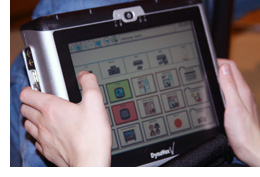 The goal of the evaluation is to decide on a communication mode or system for your child that will be fast, easy to operate, able to meet his/her communication needs, and still has the capability of expanding as your child's language skills become more sophisticated. The first order of business is to identify the current methods of communication that ARE working. For example, your child may point toward objects of desire and vocalize to protest while another nods her head to indicate, "Yes", says "Ma" to call her mother and has a working approximation for the sign, "more". Another child may not use verbal words but successfully communicates basic wants and needs by pointing, pulling, looking and tears of frustration, while a fourth may communicate verbally with close family and friends, but need family to translate his words to unfamiliar listeners. These methods of communication are probably more or less reliable and functional in different settings. Our mission is to determine a system that will be consistently reliable in all settings. To that end, we first determine how and where your child is successfully communicating. Then we explore what methods will improve upon those successes across an expanded range of people and places. The goal of the evaluation is to decide on a communication mode or system for your child that will be fast, easy to operate, able to meet his/her communication needs, and still has the capability of expanding as your child's language skills become more sophisticated. The first order of business is to identify the current methods of communication that ARE working. For example, your child may point toward objects of desire and vocalize to protest while another nods her head to indicate, "Yes", says "Ma" to call her mother and has a working approximation for the sign, "more". Another child may not use verbal words but successfully communicates basic wants and needs by pointing, pulling, looking and tears of frustration, while a fourth may communicate verbally with close family and friends, but need family to translate his words to unfamiliar listeners. These methods of communication are probably more or less reliable and functional in different settings. Our mission is to determine a system that will be consistently reliable in all settings. To that end, we first determine how and where your child is successfully communicating. Then we explore what methods will improve upon those successes across an expanded range of people and places.
To narrow our range of AAC choices, we will we will assess your child's language, cognitive, social and motor skills by reviewing results of previous evaluations, interviewing you, conducting formal testing and/or observing your child interact with the world. Next, we will partner with you to develop a set of realistic goals targeting expanded communication in identified educational, vocational, social and recreational settings. Once these pieces are in place, we will begin a trial of different AAC systems.
To systematically guide the selection of which AAC systems to try, every AAC evaluation conducted at CLASS, Inc. identifies the following:1
- A means of representing thoughts/ideas
- This could consist of any combination of pictures, drawings, photos, printed words, letters, symbols, objects, etc.
- A method of accessing the AAC system itself
- For example, by touching buttons or keys, looking at pictures, pulling a message card off of a board, or by using a switch/scanning system or an optical reader to access the messages.
- A system or tool to transmit the actual message
- Some children use communication notebooks of pictures, others use sign language or gestures, typing, computerized speech generating devices, eye gaze boards or miniature objects attached to switches.
1As supported by the research of Kangas and Lloyd (1998)
AAC Systems
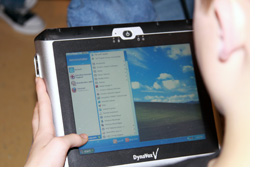 Augmentative and Alternative Communication (AAC) systems are any system, tool or device that an individual uses to supplement his or her existing communication. AAC systems are typically divided into two categories: unaided and aided. Unaided systems are those that the individual can access directly without any additional piece of equipment. Unaided systems include gestures, eye gaze, sign language, pointing, pantomiming, and facial expressions. Aided systems are those that the individual accesses through ancillary object, device or technology and can be either "Low tech" or "high tech". "Low tech" aided systems do not involve technology such as communication books, object boards, speech generating devices and computers. "High tech" aided systems do involve technology and are generally voice output communication aids (VOCAs) that can be activated by either touching buttons or via scanning with switches. Augmentative and Alternative Communication (AAC) systems are any system, tool or device that an individual uses to supplement his or her existing communication. AAC systems are typically divided into two categories: unaided and aided. Unaided systems are those that the individual can access directly without any additional piece of equipment. Unaided systems include gestures, eye gaze, sign language, pointing, pantomiming, and facial expressions. Aided systems are those that the individual accesses through ancillary object, device or technology and can be either "Low tech" or "high tech". "Low tech" aided systems do not involve technology such as communication books, object boards, speech generating devices and computers. "High tech" aided systems do involve technology and are generally voice output communication aids (VOCAs) that can be activated by either touching buttons or via scanning with switches.
- Zygo Industries
- Optimist II - [from their web page] "direct selection on an 8.4 inch screen or scanning using the dynamic display, light weight, and its audio amplifier/speaker module provides exceptionally loud, clear output"
- Polyana - [from their web site] "pocket Windows CE device, small and lightweight, are instant-on, the unit is always in standby, have long battery life on each charge and are relatively inexpensive., modified for AAC use"
- Words +
- Makers of TuffTalker - "Finger touch screen, rugged magnesium case, shock-mounted hard drive, spill-resistant LCD" [from their web pae]
- Freedom 2000 ToughBook - [from their web page] "Now with a Pentium III 500MHz Processor, a 10GB hard drive, magnesium-alloy protected LCD display, shock-mounted components, 3-Year Warranty, multiple-access modes, E Z Keys and Talking Screen, Windows Operating System
- Also a Freedom 2000 Extreme machine or a Freedom 2000 Lite version available
- Intellitools
- IntelliKeys, "the keyboard with the changing face", IntelliTalk II (text-to-speech software), IntelliPics (interactive creativity tool for teachers, parents or students), Overlay Maker for use with IntelliKeys, (solutions for switch users), or Intellitools Math are just some of the products
- Mayer-Johnson Company
- Communication Hardware - various pieces of harware for varying levels of ability. This company also has a huge selection of software and other tools too.
- Crestwood Communication Aids, Inc.
- Crespeaker Maxx II - speaks clearly in complete sentences - [from their web site] "Speaks words, phrases, or sentences in English and Spanish that you enter, translates one word from English to Spanish and Spanish to English, use to converse on the telephone, has adjustable volume and screen brightness controls, is small, light-weight - Hold in palm of hand. Fits into pocket or purse easily, very simple to operate"
- Talking Pictures and Passports - set contains [from their web page] "115 functional picture cards of survival living needs, 8 classifications - room, bathroom, health, aids, food, clothes, people, and miscellaneous, 5 languages on reverse side of card, OR 10 sign language on reverse side, 1 heavy duty vinyl envelopes to hold up to 20 pictures, 1 metal ring to hold pictures together, 1 vinyl cord to tie the ring and pictures to the bed, wheelchair, belt, wrist, etc., convenient storage box included"
- Adaptivation
- Chipper - [from their web site] "Play pre-recorded messages with a touch of the Chipper's surface or connect an external switch, message length of 20 seconds, relay/switch output capabilities for cause effect skill building, external switch jack and adjustable volume, the Chipper comes with a black base and is available in five colors-red, yellow, green, blue, and purple, threaded base (large triangle pattern) makes the Chipper extremely easy to mount to Adaptivation's Magic Arm or other mounting systems
- Sequencer - [from their web page] "This device will allow the user to have a series of messages. You can record as many phrases as needed up to 60 second maximum. Pressing the switch once causes message 1 to play. Pressing it again activates message 2, then 3, and so on. This allows individuals to carry on a conversation with a single switch. It also works well for reading a story, conducting a class report, or participating in a school play,.
- Voice Pal Max and Voice Pal Pro - lightweight, customizable personal communication aid, both can adapt to the growing skills of the user
- Able Net, Inc
- Has a communication catalog page which includes the BigMack, Quick Start Communicator, Talk Trac, and SpeakEasy Communicator
- Dynavox, a division of Sunrise Medical
- Dynamo - [from their web site] "The world's first full-featured, digitized speech device with a dynamic screen display, Dynamo allows communicators to express themselves more quickly and easily."
- DynaVox 3100 and DynaMyte 3100 - [from their web site] - "The 7-pound DynaVox features a 12-inch diagonal color display screen, which allows for more vocabulary to be displayed on a single page. This also benefits communicators with visual and fine motor impairments." and the DynaMyte is a miniature version of this [more of a hand held unit] weighing 3 lbs.
- DV and MT Series 4 - [from their web site] Word, character and recency prediction, abbreviation expansion and flexible abbreviation expansion increase the speed of communication for augmentative communicators at every level.
- The Great Talking Box Company
- Manufacturers affordable dedicated hardware and software based communication aids as well as accessories and mounting systems.
Hand-Held Communication Aids
- Words +, Inc.
- MessageMate - [from their web page] "Easy to use, available with a variety of Levels and recording times, durable construction, long-lasting battery, keyboard or switch operation, scanning capability, simple to record
- Accessories include: keyguards, carrying case, Mayer-Johnson PCS stickers, Imaginart Pick N' Stick stickers, or an extra AC adaptor
- QuickPage - [from their web page] "ready-made communication displays in a convenient, easy-to-use software program., provides customized communication displays, organizes language, builds phrases quickly, helps develop literacy skills, encourages social interaction"
- Mayer-Johnson Company
- Pocket Go Talk with Case - [from their web page]" Lightweight, portable, and durable communicator ideal for taking into the community. It's easy to record and has good voice quality with adjustable volume control. Five 7/8" x 1 1/2" message keys (5 levels) allow for 25 messages. It has 5 minutes of memory which allows 12 seconds per message. It's capable of scanning and has a switch access built in with five adjustable scanning speeds. Runs on AA batteries. Comes with a one year warranty. Carrying case included."
- Saltillo
- ChatPC - [from their web site] "ChatPC combines the latest in electronic technology with ease of use and powerful language capabilities. Built upon a new Casio EM-500 PocketPC computer, ChatPC offers a brilliant, color dynamic display along with both synthesized and digitized speech output. ChatPC is the product of a collaborative effort between Saltillo Corporation and Enkidu Research, Inc. "
- ChatBox - [from their web site] "ChatBox and ChatBox-DX, voice output communication devices, combine the use of meaningful pictorial images with the latest technology to enable people who cannot speak to communicate easily and quickly with their families, friends and others. The newly enhanced ChatBox is designed for use by any individual who experiences cognitive and language limitations, brain disorders, cerebral palsy or conditions that result in temporary loss of speech. The addition of a deluxe model, ChatBox-DX, opens up a world of capabilities to individuals with visual difficulty or very poor motor skills."
- VocaFlex - [from their web site] "With an hour of recorded speech capacity, 51 overlays can be stored into VocaFlex at once. The overlays have bar-codes that are read by VocaFlex. When a different overlay is placed on the device, the VocaFlex automatically changes the keyboard configuration and vocabulary to match the overlay."
- MessageBox - [from their web site] "Message Box is a small, portable device ideal for indoor or outdoor activities. It can be used as a starter device or as a companion to a more sophisticated system.
- Other communication aids on the Saltillo site
Individual Therapy
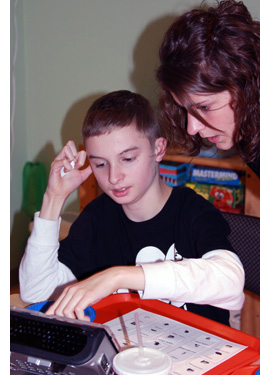 At CLASS, Inc. individual therapy services for AAC users is multimodal. We focus on efficient and effective communication by incorporating speech, vocalizations, gestures, signs, and aided communication strategies into every session. By increasing communication speed and broadening the scope of communicative topics the user can participate it we open up doors of opportunity. Therapy sessions are individualized to target the unique goals of each client; some examples of individual goals are to: inform caregivers of pain or discomfort, participate in circle time, ask for assistance, engage in academic discourse, partake in leisure activities, chat with friends/family and order food in restaurants. Individual therapy AAC therapy sessions are often the best venue for learning new skills that can then be practiced in our dyads or social skills groups and have been shown to increase our clients' participation in meaningful activities at home, school and out in the community. At CLASS, Inc. individual therapy services for AAC users is multimodal. We focus on efficient and effective communication by incorporating speech, vocalizations, gestures, signs, and aided communication strategies into every session. By increasing communication speed and broadening the scope of communicative topics the user can participate it we open up doors of opportunity. Therapy sessions are individualized to target the unique goals of each client; some examples of individual goals are to: inform caregivers of pain or discomfort, participate in circle time, ask for assistance, engage in academic discourse, partake in leisure activities, chat with friends/family and order food in restaurants. Individual therapy AAC therapy sessions are often the best venue for learning new skills that can then be practiced in our dyads or social skills groups and have been shown to increase our clients' participation in meaningful activities at home, school and out in the community.
Peer Dyad Therapy
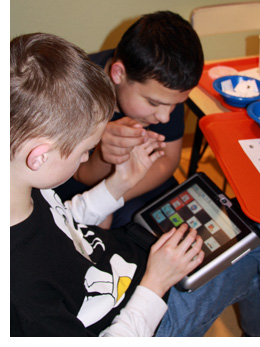 Peer Dyads are semi-structured therapy sessions where two AAC users work together toward common goals while supporting each other's individual goals. By including communication partners in the therapeutic process, the AAC user learns to attend to both his communication as well as that of his partner, thus strengthening social communication skills. This is particularly important for AAC users because their communication is inherently slower than that of non-users so they need to learn how to be as fast as possible and as engaging as possible in order to maintain the interest of their partner. Peer Dyads are semi-structured therapy sessions where two AAC users work together toward common goals while supporting each other's individual goals. By including communication partners in the therapeutic process, the AAC user learns to attend to both his communication as well as that of his partner, thus strengthening social communication skills. This is particularly important for AAC users because their communication is inherently slower than that of non-users so they need to learn how to be as fast as possible and as engaging as possible in order to maintain the interest of their partner.
Teaching Techniques
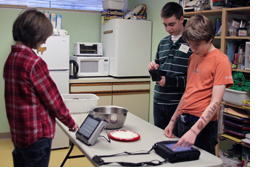 There is no single technique or composite of techniques that will work with each individual. The only common denominator is that the instructional sessions must be fun and meaningful in order for them to be integrated, maintained and applied in functional social communicative contexts. Consistency is critical for rapid learning. Goals and strategies should be consistent across environments such home, school and community (e.g. work, church, recreational settings). There is no single technique or composite of techniques that will work with each individual. The only common denominator is that the instructional sessions must be fun and meaningful in order for them to be integrated, maintained and applied in functional social communicative contexts. Consistency is critical for rapid learning. Goals and strategies should be consistent across environments such home, school and community (e.g. work, church, recreational settings).
AAC Social Groups
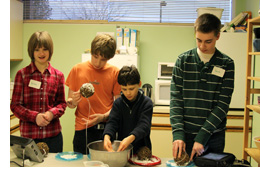 Communication encompasses much more than just telling others what you want. It involves social closeness, relaying information, asking questions, expressing empathy, engaging in humorous exchanges, revealing emotions, politely disagreeing, displaying social graces and more. Many AAC users have had little experience in social settings. Without ongoing, consistent social experiences, AAC users become socially delayed and/or lose interest in being social. Communication encompasses much more than just telling others what you want. It involves social closeness, relaying information, asking questions, expressing empathy, engaging in humorous exchanges, revealing emotions, politely disagreeing, displaying social graces and more. Many AAC users have had little experience in social settings. Without ongoing, consistent social experiences, AAC users become socially delayed and/or lose interest in being social.
AAC social skills groups target the three elements of social success as defined by Kristen Stanberry:
- Social Intake - noticing and understanding other people's speech, vocal inflection, body language, eye contact, and even cultural behaviors.
- Internal Process - interpreting what others communicate to you as well as recognizing and managing your own emotions and reactions.
- Social Output - how a person communicates with and reacts to others, through speech, gestures, and body language.
CLASS, Inc. AAC social groups teach the user all of these skills while also teaching new leisure activities such as bowling, basketball, crafts, games, gardening and community service.
Workshops/Training
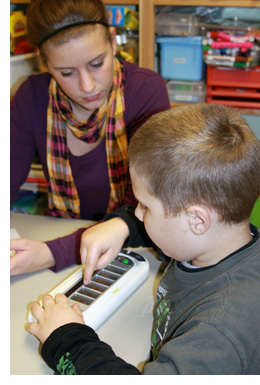 Effective training is key to the success of any AAC system. The knowledge, experience, and expertise of our staff is available to you. CLASS, Inc. offers a range of customized workshops and trainings to meet the needs of families, schools, agencies and consumers. Past topics have included: Effective training is key to the success of any AAC system. The knowledge, experience, and expertise of our staff is available to you. CLASS, Inc. offers a range of customized workshops and trainings to meet the needs of families, schools, agencies and consumers. Past topics have included:
- Introduction to AAC-The Who, What, Where, When and Why's
- Customizing AAC Systems to Meet Individual Needs
- AAC & Literacy
Local Community Partnerships:
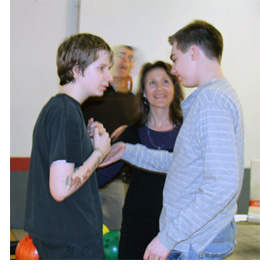 Muckleshoot Tribal School: Muckleshoot Tribal School:
For the past several years, CLASS, Inc. has had the honor of partnering with the Muckleshoot Tribal School to provide quality, affordable speech-language services to their K-12 students both on the reservation school as well as at the CLASS, Inc. clinic.
Muckleshoot Head Start Program:
CLASS, Inc. provides assessment and therapy for preschool children in this early intervention program designed to increase the social and academic skills of participants.
Tacoma School District:
CLASS, Inc. has provided expert consultation to staff and direct services to students with special challenges.
Dieringer School District:
CLASS, Inc. has delivered effective staff training in augmentative and alternative communication systems as well as direct speech-language therapy support to students grades K-12.
Tahoma School District:
CLASS, Inc. renders ongoing speech-language therapy services to students who have exceptional communication challenges that are better met through our facility with the talents and skills of our highly trained staff. In addition, ongoing consultation and training for staff is provided to support the understanding and functional use of individual AAC systems within the educational setting.
CHILD School:
Contracted to support specific children, CLASS, Inc. delivers stellar therapy services, staff training, consultation and other related support by CLASS, Inc. to ensure acquisition of functional social and communication skills.
Life Care Center of Federal Way:
Delivered on-site staff in-service about augmentative communication systems and their applications to the patients of the care center.
Pierce County Human Services:
CLASS, Inc. is contracted with the Birth To Three division to provide both assessment and therapeutic speech-language-communication services to infants and toddlers with special needs at our welcoming clinic in Federal Way.
We also conduct inservice training for the FRC's on topics including feeding, augmentative communication and early literacy skills.
Seattle School District:
CLASS, Inc. conducted staff training in feeding skills conducted for teachers, paras, nurses and others working directly or indirectly with students who are tube fed, transitioning to or from tube feedings, and/or are picky eaters.
Federal Way Birth To Three Services:
Direct speech/language therapy services to children with developmental delays and disabilities are delivered in our Federal Way clinic. Additionally, we provide training for families so that they can best support the needs of their children with communication challenges.
Multi-Service Center:
CLASS, Inc. participates in training adults re-entering the workforce through the Multi-Service Center Workforce Solutions program.
Our teen social skills and AAC social skills participants volunteer with CLASS, Inc. therapists' support at the Multi-Service Center Food Bank.
Federal Way Community Center:
CLASS, Inc. rents the gym and uses other facilities at the Federal Way Community Center to add variety to our social skills groups as well as for an age appropriate place for functional communication skills practice for our clients using augmentative communication devices.
We also participate in Community Center sponsored activities such as Friday playgroups for toddlers and preschoolers, open swim and seasonal activities.
Secoma Lanes Bowling Alley in Federal Way:
CLASS, Inc. is much appreciative for the welcoming we have repeatedly received from Secoma Lanes Bowling Alley during our multiple AAC Social Skills Group fun bowling events.
AAC Links
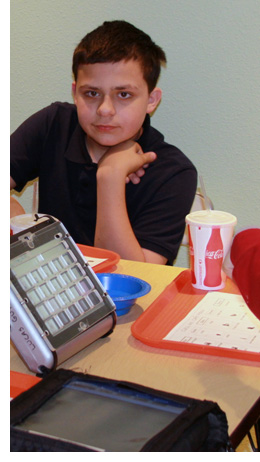 AAC Small Talk listserv. "AACsmalltalk is a safe and fun listserv (on Yahoo Groups) for kids who use AAC and their friends. A listserv is a group of kids who have something in common. When you send an email to the listserv, your message goes to all of us but you just write the letter once. You only need a computer and an email address. We're going to "small talk" about fun stuff and some important stuff, too. AAC Small Talk listserv. "AACsmalltalk is a safe and fun listserv (on Yahoo Groups) for kids who use AAC and their friends. A listserv is a group of kids who have something in common. When you send an email to the listserv, your message goes to all of us but you just write the letter once. You only need a computer and an email address. We're going to "small talk" about fun stuff and some important stuff, too.
- AAC Intervention Lots of resources as well as symbols and other printables.
- AAC Google Group For parents of children who are AAC users.
- http://aac.unl.edu/ "designed to provide access to a wide range of information and resources related to the AAC effort."
- Augmentative and Alternative Communication Connecting Young Kids (YAACK)
- Augmentative Communication, Inc. Provides resources for users and their families.
- Augmentative & Alternative Communication Devices (YouTube video)
- Augmentative and Alternative Communication (AAC) for Children with Apraxia by Dyann Rupp, MA, CCC-SLP
- Augmentative and alternative communication options for children with developmental apraxia of speech: three case studies
- Closing the Gap, "strives to provide parents and educators alike, the information and training necessary to locate, compare, and implement assistive technology."
- Dazz's View
- Jerziah Technology - Using his eyes and mouth (YouTube video)
- Meet Timmy. Adopted from a foreign country, he became a client at CLASS, Inc. due to his servere apraxia of speech. CLASS, Inc. procured an AAC system for Timmy that enabled him to tell the world what he knows, thinks and feels (YouTube video)
- "Only God Could Hear Me" (YouTube Video)
- Pixon Symbols
- PRC "Cheat Sheets"
- Sign Language and Cueing to Facilitate Speech Production in Children with Apraxia of Speech by David Hammer, M.A., CCC-SLP
- Tobii PCEye - Imagine being able to use your eyes to speak, communicate on facebook and surf the web...now you can! (YouTube Video)
- University of Washington, Seattle AAC
- Using AAC Technology To Maximize Language Development
- Using Sign Language for Children with Apraxia of Speech by Sharon Gretz, M.Ed.
- Visual Supports - Visual Aids for Learning
- Visual Supports - Autism.net
- Why is There Reluctance to Try AAC with Children with Apraxia? by Gary Cumley, Ph.D., CCC-SLP
By introducing AAC into our lives, my husband and I learned many things we didn't know about our son - for example, he could finally tell us what he really wanted for dinner, that he wanted to get out and walk around while we were parked on the ferry and that he wanted a dog. - Raven McCrackyn
|

